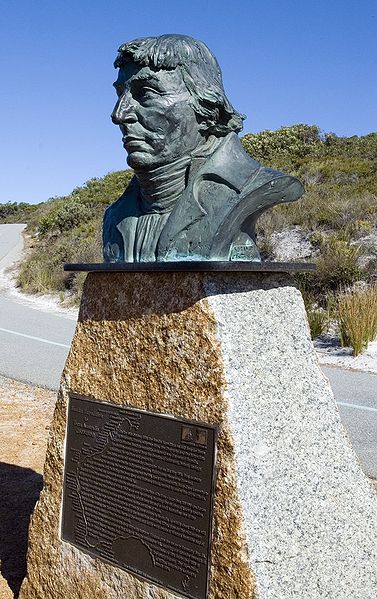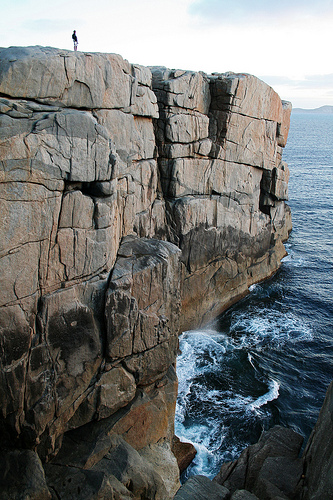Australia For Visitors > Albany, WA
Albany
Western Australia
Share this page:
Albany, located on the natural shelter of Princess Royal Harbour at the edge of King George Sound, is the oldest settlement in Western Australia. It was founded by the British in 1826 as a military and penal outpost as a way of blocking the French from exploring and colonizing the southwest of Australia. (The Swan River Colony, later to be known as Perth, was founded three years later, in 1829.)

Bust of Nicolas Baudin, a French navigator who, in 1801-02, explored the western and part of the south coasts of New Holland (as Australia was known at that time). This bust is located at Albany, WA. (Photo: Nachoman-au.)
Originally known as Frederickston, Albany's Princess Royal Harbour is superb and strategically-placed. This has resulted in Albany becoming an important port.
Firstly, Albany was a whaling port from the 1840s right through to the 1970s.
Secondly, it was a stopover and coaling station for steam ships on the Great Britain to Melbourne/Sydney/Brisbane route (that is, until the construction of artificial deepwater harbor at Fremantle in the 1890s).
Thirdly, it was the final departure point for the ships transporting A.I.F. (Australian Infantry Force) troops to Suez, Egypt and Europe during World War II. For many Australian soldiers who fought in Gallipoli (modern day Turkey) in 1915, Albany was the last bit of Australia that they saw before traveling overseas to the Great War’s battlefields.
Historical Buildings and Sights
Albany Residency Museum
This building, built in the 1850s, was once the home of the local magistrate. It is now a maritime and local history museum and also has a display of Aboriginal (indigneous) artefacts. It also includes the "Second Touch" display – a hands-on exhibition for all ages.
Nearby is a full-scale replica of the Amity, the ship that brought the original British party of settlers -- Major Edmund Lockyer and a group of convicts -- to Albany in 1826.
Stirling Terrace
Stirling Terrace features fine Victorian-era row of shopfronts. It is also the location of the Old Gaol.
The Old Gaol and Museum (1851)
A museum of colonial, Aboriginal and military artefacts, as well as the old jail cells on view.
Patrick Taylor Cottage (1832)
This cottage, built of wattle and daub, has now been carefuly restored. It is Albany’s oldest -- and possibly Western Australia’s -- oldest house. It has a display of 19th century clothing and household objects.
Strawberry Hill Farmhouse (1836)
Strawberry Hill, which was once Albany's Government Farm, used to provide the early colonists with fruit and vegetables. It is Western Australia’s oldest farm.
After your visit to the Farm, you can enjoy Devonshire tea and scones.
The Restored Post Office (1870)
This old post office building has been faithfully restored and now houses the Inter-Colonial Museum with a collection of telecommunications equipment from Western Australia’s history.
St John’s Church (1848)
The oldest Anglican church in Western Australia.
Vancouver Arts Centre
Originally the Albany Cottage Hospital (1887), the Vancouver Arts Centre houses a gallery, craft shop and a workshop area.
Princess Royal Fortress (1893)
The Princess Royal Fortress was built as a defense against naval attack on Albany, which was (and is) a strategic port in Western Australia’s southwest. The fortress was operational until mid-20th century.
Other Historical Buildings
Other historical buildings in Albany include the Courthouse, Albany Town Hall, and Pyrmont.
Bust of Nicolas Baudin
This bust (see photograph above) commemorates the French expedition (1800-04), led by Captain Nicolas Baudin, which explored much of the the western and southern coasts of Australia.
The expedition had two ships, the Geographe and the Naturaliste, and 23 scientists who were collecting information on "astronomy, botany, zoology, mineralogy, horticulture and geography".
The ships explored the Western Australia coast from Cape Leeuwin to Joseph Bonaparte Gulf. In the end, over two thirds of the Australian coastline had been charted, and much detail was added to earlier Dutch maps
Contact was made with the Aborigines.
The expedition secured 200,000 specimens of fauna and flora (2,542 were new to science). Live animals were shipped back to France, where they were house in a small museum that Empress Josephine set up in her palace at Malmaison.
The expedition named large numbers of place names in Australia -- hundreds of these French names still exist in Western Australia and South Australia today (e.g. Point D'Entrecasteaux, Archipelago of the Recherche, Bonaparte Archipelago).
Baudin then began to explore the Australia southern coastline.
On 8th April 1802 an amazing chance meeting occured when Nicolas Baudin encountered the British navigator Matthew Flinders was sailing around Australia in the opposite direction. The spot where this meeting occurred was appropriately named Encounter Bay, SA.

The Gap, Torndirrup National Park, near Albany. Note the 24 meter sheer drop to the ocean from the top of The Gap. (Photo: vanlaar.)
Great Views and Natural Attractions
Dog Rock
Dog Rock is a large granite formation which was said to have looked like the head of a labrador dog and a stopping point for most tourists to Albany.
Emu Point
Emu Point is a favorite place for swimming, boating and windsurfing.
Middleton Beach
Mt Clarence and Mt Melville
Albany has twin peaks, Mt Clarence and Mt Melville, with great views over the town of Albany, over the coast and over inland areas.
On the peak of Mt Clarence is the Desert Mounted Corps Memorial, a memorial to the Gallipoli conflict. This memorial, constructed of large granite blocks surmounted with a bronze statue of Desert Mounted Corps horsemen and their horses, was originally located in Port Said, Egypt, until it came among attack during anti-British riots during the Suez Crisis in 1956 (you can still see bullet holes on the stonework of the monument that were received during the riots).
It was then moved to Mt Clarence, Albany, an appropriate location as Albany was the departure point from Australia of troopships transporting the Desert Corps and other Australian troops to the First World War.
( More info: publicartaroundtheworld.com )
Torndirrip National Park
Torndirrip National Park, 21 km south of Albany, offers great coastal scenery -- including blowholes, The Gap (natural granite formation) and The Natural Ridge (another natural granite formation) -- plus wildflowers (in season), fauna and bushwalking.
Whaleworld
Whaling was a major industry in Albany since the 1840s until 1978. At Cheynes Beach, where the whaling station used to be, there is now a museum, Whaleworld, which includes the old whale process station, a whale chasing ship, and whale skeletons.
Two Peoples Bay Reserve, 24 km east of Albany, is home to the noisy scrub bird. In the area, you can visit Marron Farm and also Valley Ponds Trout Farm.
Share this page:
Author: David Paul Wagner
(David Paul Wagner on Google+)
|